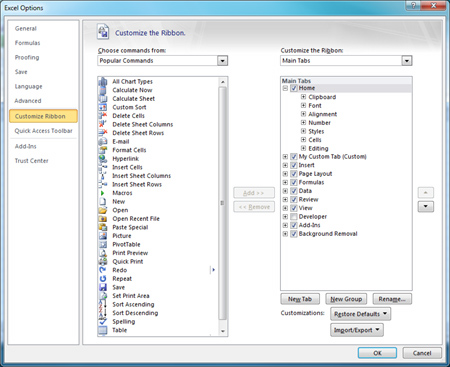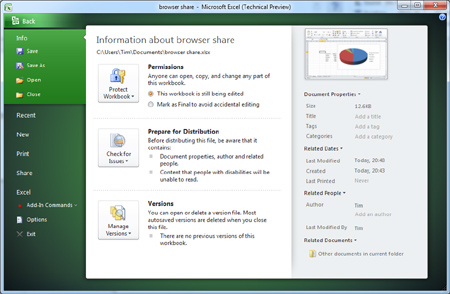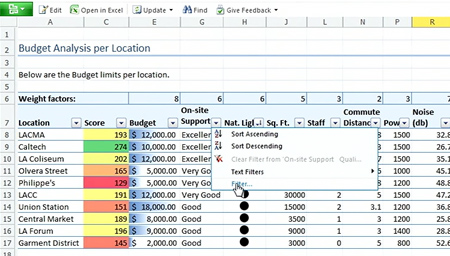Original URL: https://www.theregister.com/2009/07/13/office_2010_preview/
Office 2010 tech preview: Expect the expected
And some web apps (eventually)
Posted in OSes, 13th July 2009 14:02 GMT
Review Microsoft has released a technical preview of Office 2010. This is a pre-beta release intended for feedback, as well as promotion, so it's not feature-complete and may change before the final release planned for the first half of 2010.
Nevertheless, it offers a fair guide to what Microsoft is planning for its ubiquitous office suite. The short summary is 'more of the same': more of the controversial Office Ribbon UI, more features for products that arguably have too many already, and more integration with SharePoint so that users are drawn deeper into Microsoft's platform.
At the same time, the company is looking perhaps nervously at web-based Office suites from Google, Zoho, Adobe, and others and responding with Office web applications of its own, while carefully avoiding any suggestion that they might replace the desk-bound versions.
"I wouldn't give up the full capabilities of my Office applications on my PC," says Office product manager Monica Mendoza. "But isn't it great to know that you can access your Office files from anywhere, directly in a browser?" Considering the importance of Office to its bottom line, you would not expect Microsoft so say anything else, but it is a complex message to articulate.

Customize the Office Ribbon, as you could with the pre-2007 toolbars
The big themes of Office 2007 were new XML-based document formats, which sparked a ferocious standards war, and the disappearance of menus in favour of a fat-tabbed toolbar called the Ribbon. Web apps aside, there is nothing so radical here. Office 2010 feels more like a refinement of the earlier version. The Ribbon is now extended to Outlook and Publisher. One crumb of comfort for Ribbon-haters: a "customise the Ribbon" option has appeared, letting you add and remove tabs, groups, and individual commands.
As for Open XML, it's notable that Microsoft neglects to mention it at all in its Reviewer's Guide, even though this is supposedly the release that will fully implement ISO/IEC 29500. It is odd how this has gone from a cause to campaign for, to not-worth-mentioning in just over a year. To be fair, few users ever cared about XML formats themselves: it is only when documents get scrambled or fail to open that such things become important.
So what is new here? 64-bit versions for a start. They're now an option throughout. The most obvious use is gigabyte-size Excel spreadsheets, though working with any large document should now be easier. Excel also gets a new single-cell chart type called a Sparkline and a new Slicer tool for filtering data. Some features turn up throughout the product.
The Office Button - really a file menu, and one which some new users find hard to discover in Office 2007 - has been replaced by a Backstage view, combining file, preview, and document options into one full-window dialog. It sounds odd, but it works well. Paste Preview is another new feature, showing an instant preview of Paste actions.

Backstage View replaces the Office button to combine the File menu and previews
Ideal for product reviewers, a screenshot button lets you insert an image of any open window into the current document. Several Office applications now support simultaneous multi-user editing, provided the document is hosted on SharePoint or Windows Live.
Video inserts
Another theme is multimedia support. You can insert videos in PowerPoint and trim and format them with built-in tools. PowerPoint also gains new transition and animation effects, along with bitmap effects such as artistic filters and control over colour saturation and tone.

Trim and format video in PowerPoint 2010
The web apps were not in the preview we received, since they are dependent on SharePoint or SharePoint Services 2010, but video presentations suggest they offer high-quality rendering and editing. There is a collaboration aspect, since more than one person can work on a web document simultaneously. Word, Excel, PowerPoint, and OneNote are supported, with Silverlight used on the client where available and dropping down to HTML where necessary.

Applications such as Excel can be accessed online via a browser
Supported browsers are IE, Firefox and Safari, or Windows Mobile. Since this is SharePoint, you can also open a web document in the full Office application and save it back in a seamless manner. Businesses will either host web apps on their own servers or via a hosting provider, which could be Microsoft itself. Individuals will get this feature via Windows Live, probably for free. They look great from the little we have seen so far.
Microsoft Groove, a relatively little-used collaboration product, is now renamed SharePoint Workspace and can be used to replicate SharePoint sites locally, in addition to its existing peer-to-peer workspace support. This enables offline support for SharePoint, with synchronisation back to the server when available. Outlook has not changed much in the preview, though it has gained a new kind of macro called Quick Steps, as well as the ribbon UI already mentioned.
Speaking of macros, the old Visual Basic for Applications continues to live in Office, which will be reassuring to those with existing VBA solutions. Word has a new Navigation Pane, an enhanced version of the existing Document Map, which supports search and preview as well as once-click navigation to specific headings.
It is hard to get excited about Office 2010, simply because this is the umpteenth version and its core features are little changed. That said, 64-bit support will be great for those who need it, while the forthcoming web apps are a significant new twist in the long Office story. ®